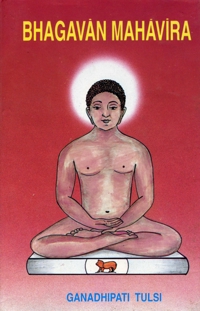 | Chapter 5 | Foundation Of Religious Order |

ndrabhuti Gautama was an erudite and versatile scholar having encyclopaedic knowledge. But his knowledge resulted in turning him extremely self-conceited. It is a common saying that learning purges man of egotism and makes him humble. But it is a common experience that it creates a superiority complex and reduces humility in man. What is true - the common saying or the common experience? The doctrine of anekanta would hold that both of them are true: In the context of the spiritual learning, the former is found true, while in the context of the mundane knowledge, the latter holds good.
No sooner did Indrabhuti enter the domain of the spiritual learning than his egotism evaporated, and he was filled with a sense of modesty.
A new thirst for knowledge was awakened in him.
| He approached Bhagavan Mahavira and asked him enquiringly, | "Bhagavan, what is Reality?" |
| Bhagavan Mahavira replied, | "Becoming." |
| Gautama repeated his question, | "What is Reality?" |
| Bhagavan Mahavira replied, | "Non-becoming." |
| Gautama repeated his question again, | "What is Reality?" |
| Bhagavan Mahavira replied, | "Being.” |

Bhagavan Mahavira revealed to Gautama the basic formula of the theory of anekanta in the form of this triad:
- becoming, i.e., coming into existence, non-becoming, i.e., ceasing to exist, and being, i.e., subsisting.
Thus he imparted to him the essence of his philosophy.
The eternalists held that reality is eternal, while the non-eternalists believed it to be transitory.
Bhagavan Mahavira did not agree with either.
According to him, there is nothing either absolutely eternal or absolutely transitory.
He professed that the reality is a synthesis of eternity and transitoriness.
-
- Reality is transitory because it is possessed of becoming and non-becoming.
- But it is eternal because by its very nature, it is subsistent.
- The reality is a synthesis of becoming, non-becoming and being.
- Whatever is real must be possessed of becoming, non-becoming and being.
-
- 'Being' bereft of 'becoming', and 'non-becoming' as well as 'becoming' and 'non-becoming' bereft of 'being' are absurdities.
In this discourse, Bhagavan Mahavira enlightened Gautama to comprehend the reality in the right perspective.
This enlightenment enabled Gautama to perceive the reality.
Gautama imbibed the doctrine of anekanta on the basis of which he compiled Bhagavan Mahavira's teachings in the twelve angas (canons). The following are the twelve angas and their subjects:
| 1 | Acarang | Monasticism and spiritual discipline |
| 2 | Sutrakrtanga | Monasticism and spiritual discipline |
| 3 | Sthananga | It expounds the above subjects in numerical sets of one to ten. |
| 4 | Samavayanga | It discusses in a numerical system the above subjects |
| 5 | Bhagavati | Ontology and Philosophy |
| 6 | Jnatadharmakatha | Parables |
| 7 | Upasokadasa | The acara or ethical conduct of the lay followers. |
| 8 | Antakrddasa | Narrations about people who have attained emancipation |
| 9 | Anuttaropapatikadasa | Narrations about people born in the Anuttara Vimana (the highest class of gods) |
| 10 | Prasnavyakarana 1) | It discusses the five types of asravas (influx of karma) and sarhvara (cessation of asravas) |
| 11 | Vipaka | It deals with the effects of karma (action) |
| 12 | Drstivada | Nayavidya (Science of Perspectives) |
| 1) The old version of Prasnavyakaranadealt wth the various kinds of sciences of angustha, prasna etc. |
Like Gautama many other scholars attended Bhagavan Mahavira's discourse. They also expressed their desire to know the nature of Reality. Bhagavan Mahavira enlightened them with the philosophy of anekanta and sharpened their spiritual propensities. Just as they excelled in the Vedic and secular sciences, so also they attained perfection in the knowledge propounded by the Arhats.
 Acharya Tulsi
Acharya Tulsi

